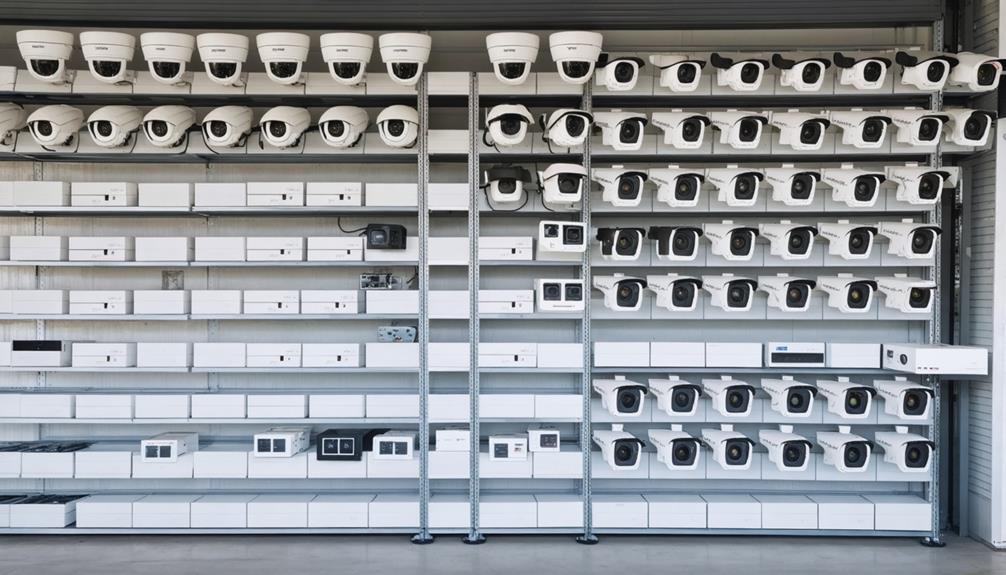
Brainstorm Security Shop

For Orders Over $199

On Any Of Our Products

Details On Refund Page

The landscape of surveillance camera technology is rapidly evolving, prompting organizations to reconsider their procurement strategies. Investing in a surveillance camera wholesale has emerged as a cost-effective solution, allowing businesses to acquire advanced security systems without straining financial resources. However, while the financial incentives are clear, questions about selecting the right features and navigating the complex supplier market remain. As the industry continues to innovate, understanding these dynamics becomes crucial for maximizing investment returns. What strategies can organizations employ to ensure they are making informed decisions in this fast-paced sector? The answers could redefine your approach to security management.
In recent years, the surveillance camera industry has witnessed significant advancements, driven by technological innovation and evolving security needs. One of the most notable trends is the integration of artificial intelligence (AI) into camera systems. AI integration enhances video analytics, enabling real-time threat detection and improved decision-making capabilities. This technology also allows for advanced features such as facial recognition and behavioral analysis, meeting increasing consumer demand for smart security solutions.
However, with these advancements come heightened privacy concerns. As surveillance cameras become more sophisticated, the potential for misuse and invasion of privacy has raised alarms, prompting calls for stricter regulations and ethical guidelines.
Another emerging trend is the shift toward cloud storage solutions. Cloud storage provides scalable and secure options for storing video footage, offering remote access capabilities for users to monitor their premises from anywhere.
Despite the promising advancements, installation challenges remain a concern, particularly in integrating these complex systems into existing infrastructures. The market competition is fierce, with numerous players vying to offer the most innovative and cost-effective solutions.
As a result, companies are under pressure to continuously innovate and address consumers’ evolving needs, balancing technological advancement with privacy and security considerations.
As the surveillance camera industry continues to evolve with technological advancements, purchasing strategies also adapt to meet the demands of both businesses and consumers. One significant advantage of buying wholesale is the opportunity for substantial cost savings. By engaging in bulk purchasing, businesses can procure surveillance cameras at reduced per-unit prices, allowing for more efficient allocation of their security budget. This pricing advantage is particularly beneficial for large-scale installations, where the need for multiple cameras is paramount.
Buying wholesale not only offers economic benefits but also streamlines the procurement process. Purchasing in bulk reduces the frequency of orders and associated administrative tasks, leading to further savings in time and resources. This efficiency is critical for businesses that require a swift deployment of surveillance solutions to maintain security and operational continuity.
Additionally, wholesale purchasing can enhance inventory management. By acquiring a larger quantity of cameras at once, businesses can ensure they have sufficient stock to meet immediate and future surveillance needs. This preparedness is vital in rapidly evolving security scenarios where quick adaptability is required.
When selecting surveillance cameras, understanding the key features is essential for ensuring optimal performance and security. One of the most critical aspects to consider is video quality. High-resolution cameras capture clearer images, which is vital for identifying details such as facial features or license plate numbers. Cameras capable of producing at least 1080p resolution are recommended for most applications, though higher resolutions like 4K provide superior clarity, albeit often at a higher cost and storage requirement.
Another important feature is the installation options available. Surveillance cameras come in various forms, including wired, wireless, and PoE (Power over Ethernet). Wired cameras generally offer consistent performance and are less susceptible to interference, making them suitable for permanent installations. Conversely, wireless cameras provide flexibility in placement but may require robust network infrastructure to ensure uninterrupted video transmission.
PoE cameras combine the advantages of both by transmitting data and power over a single cable, simplifying installation and reducing clutter.
Additionally, consider other features like night vision, motion detection, and field of view, which enhance the camera’s utility in different environments. Assessing these features in relation to your specific security needs is crucial for making an informed decision.
Finding the right supplier in the surveillance camera market requires a strategic approach, as the landscape is populated with numerous vendors offering a wide range of products. Developing robust supplier relationships is critical for ensuring consistent product quality and competitive pricing. Conducting a thorough market analysis is fundamental in identifying vendors that align with your business needs. This involves assessing factors such as product range, technological innovation, and customer service capabilities.
The following table summarizes key considerations when navigating the supplier market:
| Consideration | Description |
|---|---|
| Product Quality | Evaluate the quality of cameras and warranties. |
| Pricing Structure | Analyze cost-effectiveness and volume discounts. |
| Technological Edge | Assess the latest innovations offered by the vendor. |
| Customer Support | Review the level of after-sales support provided. |
| Supplier Reputation | Investigate the vendor’s market credibility. |
Strategically choosing a supplier can significantly impact business operations. A supplier with a strong reputation and comprehensive support can enhance business growth and stability. Moreover, understanding the supplier’s market position through effective market analysis can provide insights into potential risks and opportunities, ultimately leading to better decision-making. By focusing on these critical factors, businesses can proficiently navigate the complex supplier market landscape in the surveillance camera industry.
Navigating the supplier market effectively positions businesses to capitalize on emerging trends in surveillance technology. Central to these advancements is the integration of artificial intelligence (AI), which is poised to revolutionize the capabilities of surveillance systems. AI enhances the functionality of cameras by enabling features such as real-time facial recognition, anomaly detection, and predictive analytics.
This evolution not only increases the efficiency of monitoring systems but also transforms how data is interpreted and utilized.
However, with these technological advancements arise significant privacy concerns. The ability of AI to analyze vast amounts of data raises questions about data protection and the potential for misuse. Surveillance technology must therefore balance innovation with ethical considerations, ensuring compliance with privacy laws and regulations to maintain public trust.
As businesses explore these cutting-edge technologies, they must engage with suppliers who are not only technologically proficient but also deeply versed in privacy issues. By prioritizing partnerships with forward-thinking companies, businesses can ensure that their surveillance solutions are both advanced and ethical.
In doing so, they will be better equipped to navigate the complexities of modern surveillance, safeguarding both security and individual privacy in an ever-evolving digital landscape.
When installing surveillance cameras, legal considerations include adhering to installation regulations and obtaining necessary consent. Compliance with privacy laws, such as ensuring cameras do not infringe on personal spaces, is essential to avoid legal repercussions and safeguard individuals’ rights.
To ensure privacy, consider strategic camera placement to minimize intrusion into private spaces. Adhere to ethical considerations by informing individuals about monitoring practices and implementing data protection measures to prevent unauthorized access and misuse of recorded footage.
Common warranty terms for surveillance cameras typically include coverage for manufacturing defects, with durations often aligning with the expected product lifespan. Warranty coverage can range from one to three years, depending on the manufacturer’s policy and product specifications.
When considering bulk purchasing, financing plans are often available to facilitate large transactions. These plans can include flexible payment terms, interest rates, and credit lines, enabling businesses to manage cash flow while acquiring necessary equipment.
Proper disposal of outdated or broken surveillance cameras involves adhering to electronic recycling guidelines. Utilize certified e-waste recycling programs or facilities to ensure safe disposal, thereby minimizing environmental impact and adhering to local regulations on electronic waste.
Brainstorm Security Shop
1867 Caravan Trail
Ste 105
Jacksonville, FL 32216
Call us toll free: (800) 859-5566